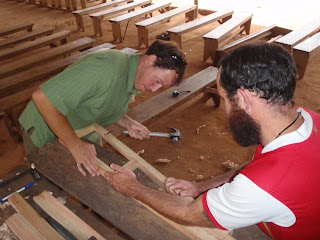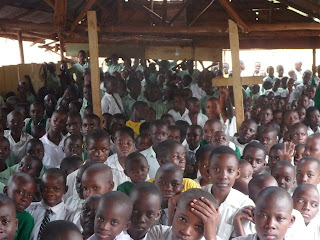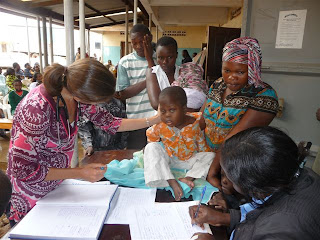As most of you know, we were sent to Uganda by AJWS To work as capacity builders in an NGO. We were partnered up with KCCC – Kamwokya Christian Caring Community – a church-based, grass roots organization dedicated to providing services to one of the more impoverished areas of Kampala: the 60,000-person Kamwokya slum. The slum is a mix of Uganda’s poor: the downtrodden, northern refugees escaping the LRA, South Sudanese, Congolese, orphans of war and HIV, lepers and polio victims.

KCCC knew I was a PT, but they didn’t quite know what it means. Uganda, a country of 33 million people, produces 20 PTs a year, or 1 PT for every 1.65 million people, this is quite an improvement over a few years ago, when Uganda’s Makerere university produced only 10 a year. The Human Resources director, an amicable chap who thought PTs cured tuberculosis thought I might be best used in the dispensary, or pharmacy. Soon, Rusha and I realized that if we did not take the leading role in directing our projects, we would both be doing fairly trivial things, and not using our skills effectively.
I needed to start off with a serious needs assessment. I petitioned the clinic docs and staff to give me a room once a week and send me patients that could use PT intervention. While some wildly missed the mark -Septic knees diagnosed as “Tibial dislocation” and a Bell’s palsy- most cases could use PT services.
I also advertised myself to the front line folks, the Community based Volunteers and Health workers (CBV and CBHWs), 32 HIV positive clients and community members who’s job is to call on the clinic’s patients at home, make sure they are taking their medication, counting pills, advocating, bringing problems to the attention of the doctors, and maintaining communication with our patients in the field. These workers are an invaluable resource, as they are respected community members who know the community and have intimate knowledge of the slum, essential to successfully navigating an African community.

As I went out into the community, making house calls and visiting, I realized the extent of disability in the slum. Hidden in homes, carried on backs, sitting on stoops, people with disabilities were everywhere. Cerebral Palsy, malarial and congenital, drop foot from improper quinine injections, rickets, and trauma, leprosy and polio.
I knew that providing primary care to this ocean of disabled people as the only PT in the slum was not a sustainable approach, nor was KCCC addressing disability issues. However I didn’t know how to address something of this magnitude. So I started doing some research on the slowest internet connection known to man. I discovered 2 things: the first is that organizations have been addressing disability in Uganda since the mid 60’s, with some success. These programs focused on many aspects: advocacy, polio, leprocy, however, the majority of the organizations focused on children. Secondly, I learned about a rehabilitation concept adapted by the World Health Organization years back called Community Based Rehabilitation (CBR). CBR is a holistic approach to rehabilitation used where formal medical knowledge is lacking and medical infrastructure non-existent. The idea was to use a holistic approach whereby the community becomes empowered and educated to care for themselves. Since disability is more then disease, but a loss of function and ability to participate in the mainstream world, in parts of poverty stricken Africa, where inability meant death or life threatening burden to the community, CBR called on addressing disability from a cultural, economic, educational, and medical perspectives.I began to contact some of the organizations that dealt with disability in Uganda. I contacted and spoke with advocacy and educational associations, disability NGOs, the PT department at Mulago Hospital, Uganda’s referral center, the association for the blind and deaf. For every NGO or entity that I made contact with, many lead to dead ends.
Getting to understand CBR, I could see that KCCC was well positioned for such a comprehensive approach. We already had a successful micro-loan and income generation program in the form of a cooperative bank. We run a primary school and child counseling and advocacy, we have a medical clinic, a vocational training program, and most importantly, access to and trust of the community.

I began working at the vocational school, thinking that building adaptive equipment using local materials, and possibly training some of the staff and students was a good place to start. We built our first pair of crutches for less then $2, planing the wood ourselves the old fashioned way. I commissioned hand and knee paddles to be made as a prototype for use by people with polio who walk on their hands and knees. This generally produced the desired effect, interest from the staff and participation, curiosity at a new potential source of service, income as well as training and potential employment for students.
I also contacted 2 very promising leads; the first was a newly built

surgical hospital called CoRSU, a well-staffed and well-funded orthopaedics and plastics hospital. CoRSU was pleased to make contact with KCCC, and after seeing Rusha and I on television after we ran the Buganda road race (if you didn’t read that blog entry, Rusha came in second, I limped along, but we both were interviewed on national television, which I think gave us some buy-in from people who saw us as famous mzungus) they were eager to partner with us. The most promising of partners was a place called Katalemwa Cheshire homes (KCH), a Ugandan NGO since the 60’s that provides comprehensive rehabilitation services in a CBR framework to children.
My idea was taking shape: I would train a small core group of KCCC staff who would become CBVs trained in the concepts of CBR and disability care and prevention. I would involve the different branches of KCCC, the bank, the vocational training center etc…for the holistic approach, and

we would partner with KCH to provide rehabilitation services, education, and a new referral source for KCCC.
I pitched the idea to management, emphasizing that this approach is sustainable because most mechanisms were already in place, and that the main burden, that of rehabilitative care would fall on KCH while we would do what we already do best, community mobilization, sensitization, and using existing resources.
We chose a team from among our staff to become the CBR core group. These consisted of medical officers, nurses, counselors, teachers and CBHW. I lectured and we discussed various topics on a weekly basis (or whenever they showed up, or I was able to coerce them to come with the promise of soda): Disability concepts, advocacy, education and family training, diagnosis, pathophysiology, physical treatment, adaptive equipment and more. All at a very basic level, always emphasizing community sensitization, identification, and referral.
For a PT, or anyone for that matter, Uganda’s beliefs about disability are fascinating. Most people believe that disability and mental illness are punishment for a sin someone committed in a former life, or curse that was put on the family, or possibly Juju. Children are hidden in back rooms, under beds, and in bathrooms, never to be brought outside. Women are too proud of their womanhood to give birth at medical centers, giving birth in homes, in a pharmacy’s stock room, and paying the price when things go wrong. Disability and its cause are sometimes disease we in the West saw 100 or more years ago: Polio, Leprosy, Rickets, Cerebral malaria. We also saw post injection paralysis (Quinine, an anti-malarial, is injected directly into the sciatic nerve by an untrained person destroying the nerve and creating permanent foot drop), horrible and unnecessary trauma from accidents, osteomyelitis, and more.

I continued to see patients once a week in my little PT clinic, using the few basic things I brought: McConnell and athletic tape, Elastic bandages, and an ice pack. Practicing was fun, and Africa allowed for some liberties. I could prescribe medicines or order x-rays. The cases were interesting and diverse, from devastating strokes, acute osteomyelitis and septic infections, to back pain, trauma, and paralysis. Some were appropriate. Others not, some we were able to treat with good results, others with no effect, however, all my patients were grateful for the effort.
Together with KCH, we hashed out a proposal that would benefit both organizations. KCH would provide us with education, access for our patients to their rehabilitation center and services. They would also provide our staff with training, help us with our CBR program, and most importantly, they would provide quarterly clinic days, where they would come to our community and provide assessment, education, diagnosis, referral, and treatment to children with disabilities. In return, we would provide them with community mobilization, a venue, access to our bank, and open our school to children with disabilities.

I believed the first clinic day would cement the CBR program. Not only would we tangibly provide rehabilitative services to the slum, but the CBR team would get a hands on training day with an experienced team, KCCC would see the benefits of the program, and the community would get the care they required, spurring them to press KCCC to maintain the program when I left and ensure continuity and sustainability.
When clinic day came it went great. After a week of mobilizing the community by driving around the slum announcing the event by mega-phone on a pick-up, through community elders, word of mouth, schools, and the primary health clinic, the big day finally came.

Despite heavy rain – an all-stopper in Uganda – 150 people came. We assessed 50 children with disabilities, providing diagnosis and referral and treatment. We tested and counseled 35 people for HIV. We had a full day of talks and demonstration, on saving and creating income, vocational training, disability awareness, and more. Both KCCC and KCH took notice of the turn out and the good organization and vowed to continue the relationship and help it grow. The community was thankful, and most importantly, children got much needed and deserved services.
My hope is that KCCC can sustain a basic CBR

program. By sharing ideas, resources, and services, and creating a partnership whereby each

partner brings what they are best at to the table. In this way, KCCC, with little investment and some basic training, can provide rehabilitative services to the community which it serves. In the end, like everything in life, I got the most out of the experience. As always, the intimate invitation to share a moment in someone’s life, and this time, someone as different from me as a slum-dwelling Ugandan, is what I cherish most, and the work in Uganda was some of the best I have had the opportunity to do in my life.
